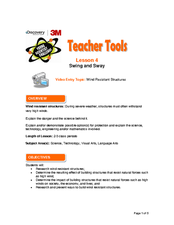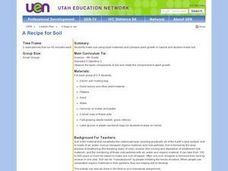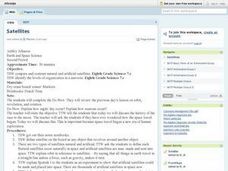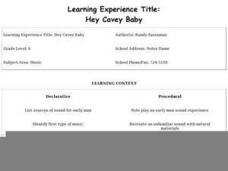Curated OER
Hlf-Ball
Young scholars investigate Newton's Laws of Motion and the Law of Conservation of Energy. They examine how a ball and half-ball behave and relate these laws to what happens to the ball. Students produce a graph of the data collected...
Curated OER
Lessons in Loss, Year of Impossible Goodbyes
Students determine how the Korean people dealt with the loss of their land and traditional lifestyle in response to invasion and emigration. They create a list of items and people they have lost. From this they complete a journal...
Curated OER
Life Giving Rivers
Students examine the world's rivers in this six lessons unit which mingles science with social studies. The dynamic forces that create erosion in nature are also seen as habitats and ecosystems that are affected by environmental and man...
Curated OER
Lesson: Sand and Water
Young scholars review background information about water tension and adhesive forces on sand. In this sand science lesson, students visit a beach and have a sand building competition near water and away from it. Young scholars discuss...
Curated OER
Swing and Sway
Middle schoolers research the destructive force of the wind. In this science lesson, students design and build a wind resistant structure. They explain why they chose a particular design and present their structure in class.
Curated OER
Pre-Trip Readiness
Young scholars demonstrate an understanding of one of the forces, floods, affecting Yosemite. After watching a video of a 1997 flood of the valley, students go to a website imbedded in this plan and answer questions.
Curated OER
The Legendary Raptors
How are raptors and airplanes alike? Combine science and language arts in this fun and interactive project. Young scientists research the animal in order to design their own aircraft, and compete in a contest for farthest, fastest, and...
Curated OER
Can You Control Floods
Students assume the role of an engineer or planner. As an engineer or planner they must come up with ideas that can be put into place to control floods. They produce a working model of flood control.
Curated OER
Where People Work
Students investigate where people work. In this social studies instructional activity, students use a Landscape Picture to locate places of work. Students discuss how each job is similar and different.
Curated OER
Avalanche!
Pupils explain that when forces on an object are balanced, the motion of object does not change. They describe how an object changes its motion when forces on it are unbalanced. They plan and conduct a scientific investigation to test a...
Curated OER
Ignoring Friction - Not This Time!
Students discover the factors affect friction. Students, working in lab pairs, complete various experiments in order to discover what factors effect the amount of frictional force a block has as it is pulled across different surfaces.
Curated OER
Aerodynamics of Cycling
High schoolers study aerodynamic forces - lift and drag - and see how those forces affect cycling performance. They see how those forces are calculated and how
Curated OER
Exploring and Comparing Other Communities
Third graders search TDC database for images of physical geography maps, weather maps, natural resources maps, and old travel brochures. They create a new travel brochure of an area of their choice using the information they gathered.
Curated OER
A Recipe for Soil
Fourth graders use local materials such as leaves and other plant matter; sand and pebbles to make soil. They plant seeds in the manufactured soil and in natural soil and then observe and record the results.
Curated OER
Satellites
Eighth graders explore the history of space travel and satellites. Through a teacher demonstration, 8th graders observe how a satellite revolves another object. They identify natural and artificial satellites, explore how satellites...
Curated OER
The Siberian Arctic
Students, in groups, research the topics: habitats of northwestern Siberia, reindeer, oil and natural gas, and other threatened regions of the Arctic. They answer specific research questions based on their topic. They use online...
Curated OER
Aerodynamics of a Boomerang
Students examine how aerodynamic forces affect the flight of aircraft, animals and sports balls and projectiles (like a javelin or boomerang). They discover the origins of the boomerang and early usage in hunting.
Curated OER
Affluenza
Students are introduced to the "disease" of affluenza. After watching a documentary, they identify the forces that have changed the nation into a consumer society. As a class, they discuss ways to avoid catching on to this phenomenon.
Curated OER
Hey Cavey Baby
Ninth graders create an unfamiliar sound with natural materials. They role play an early man sound experience. They imagine themselves a member of a clan of early people.
Curated OER
Very Big Company
Students describe the problems of political independence without economic independence. They evaluate the natural resources, human resources and industrial resources of a country and make economic decisions. They evaluate strengths and...
Curated OER
Betty Mae Jumper and The Second Seminole War
Fifth graders describe the reasons for, nature of, and outcomes of the Second Seminole War. They determine that Seminole women and men faced many hardships as they fought for their survival. They relate a story of a Seminole "first"...
Curated OER
Presenting Ecology through Rodent Control
Students role play the member of a health department task force. In groups, they develop their own recommendations to control the rodent problem in the area. They email their local government official and research information about the...
Curated OER
Let's Make Waves
Students investigate the concept of waves and how they are formed. The force of wind is demonstrated as the prime factor to the creation of ocean waves. Students research the concept in detail for better comprehension.
American Battlefield Trust
Antietam 360
It was the single bloodiest day in Civil War history. Now, class members have the opportunity to walk in the footsteps of soldiers who fought in the Battle of Antietam using an interactive website. Supplemental resources include...

























